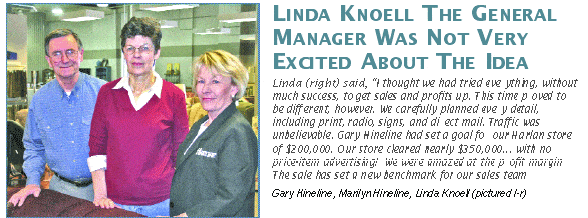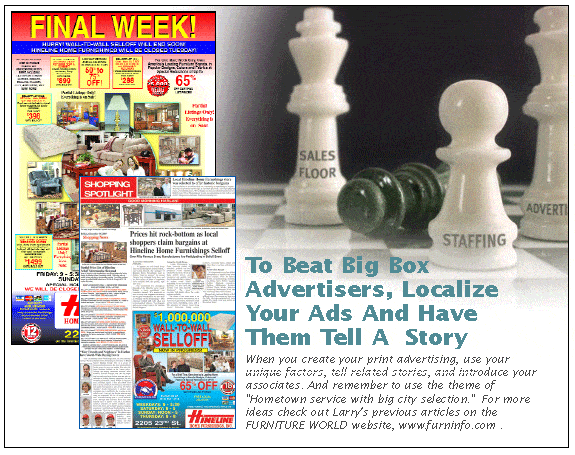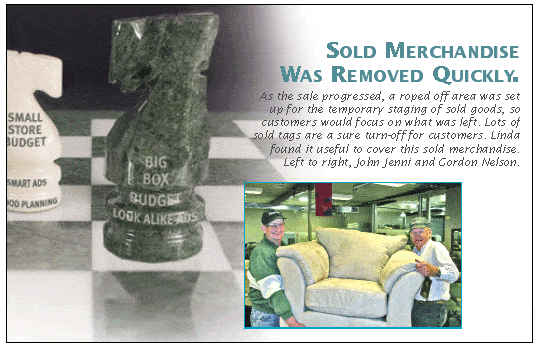Part 3: How to apply advertising know-how.
A case history - Hineline Home Furnishings.
Hineline Home Furnishings, a 30,000 square foot store could not have a tougher marketing challenge. This independent retailer competes for business in a city of less than 6,000 people, and does it in the virtual shadow of Nebraska Furniture Mart. Gary Hineline, the store owner does have a few especially important strengths: He is open to new ideas; has a powerhouse General Manager, Linda Knoell; and has an excellent staff of associates who are dedicated to making the program work.
A REVIEW OF THE PROBLEM: The store is located in Harlan, Iowa, a city of less than 6,000 people. It must do business in the shadow of Nebraska Furniture Mart, just a few miles away. There is lots of inventory on hand and a limited ad budget. That was the situation facing Linda Knoell, the general manager of Hineline Home Furnishings stores, late last summer. And then owner Gary Hineline approached her with a startling idea.
He said, “Linda, I want to do a big sales event in our Harlan store. Bigger than we have ever done. We are overstocked and new shipments are on the way. I recognize that this is a big challenge for even an experienced manager like you. Do you think you can do it? I will give you all the help I can.”
Linda was open to doing things in a new way, able to put her ego aside and follow a high-impact plan exactly. However, the story of Gary and Linda’s sale is really one of leadership, great teamwork and a “can-do” attitude. Virtually everyone on the Hineline staff was involved in the sequences of planning, preparing and executing the sale. And here is the first key secret to a successful furniture promotion: TIMEFRAME all of your activities when planning a big event.
The Five-Step Timeframing Technique
There are two simple rules to understand when you timeframe an event:
- Focus On Each Of The Five Timeframing Steps In Its Proper Sequence. For Example: STICK TO YOUR PLAN unless something out of sequence that is truly urgent demands attention. Don’t second guess your Planning Step when you are in the middle of your Preparation Step. Don’t indulge in “We should haves” when your Sale is in progress. Go for it!

- Master Each Step Before You Attempt the Next Step. It is too late to be “Learning” essentials when you are “Planning.” It’s too late to “Plan” when you are “Preparing.” It’s too late to “Prepare” when the sale is in progress!
The Five Timeframing Steps
LEARN: Refresh your expertise. Vince Lombardi said it best: “If you think you are green, you will continue to grow. If you think you are ripe, you begin to get rotten.” Nearly everything you need to know about executing a successful sales event can be found in the Furniture World article archives. There are at least a dozen articles there that provide in-depth coverage of all the sequences involved in planning and executing a big sales event. (A summary of these ideas was included in the February/ March issue that is archived on the www.furninfo.com site). When Linda was interviewed for this article, she emphasized that she had read the guidelines several times. When in doubt, she asked for clarification.
PLAN: Establish a target date for the event. Get your team leaders together to help you create a media and activity calendar, a budget, and to make a list of everything you can think of that must be done for the event. Each activity must be delegated, so plan at least two general meetings for the Preparation stage. Plan advertising placement, buy and place radio spots and arrange the printing and timely delivery of the mail piece. Plan all sales contests, signs, sales tags, sales kits, etc. Have a parking and crowd plan.

PREPARE: During the Preparation period have your meetings. Each task must be assigned to someone. The primary leader must oversee the activities, including preparation of printing and preparing price tags, name tags, media buys, and so on. Delegate any jobs you can. Don’t attempt to do it all. Make sure the responsible person signs off on his or her assigned tasks. Linda Knoell followed directions, held preparation meetings with her staff, got feedback, brainstormed, and listened to the best thinking of everyone. She insisted on having a spic and span store for the event.
She prepared detailed orders, from cleaning the service counters to attention to corners. By the time the sale was set into motion Linda knew, and her staff knew, what needed to be done, when to do it, and who was responsible to do it. She followed her calendar plan exactly, and kept her staff informed. During the preparation stage you must follow-up on every activity that has been delegated. I suggest setting up a central area that shows everyone all the activities that are going on and who is responsible for what.
Keep in mind that the very first thing that must be attended to is the Private Sale letter. This must be created early in the game and coordinated with your mailing list. Obviously, your mailing list must be updated and current. Devise a plan to capture new names during your sales event. Be sure you and some key staff members are on the mailing list. Next in urgency is the printing of special tags for the event, and window signs. You will need at least a two week window for all the meetings and preparation sequences.
EXECUTE: When your event is in progress, it’s time for positive thinking, smiling faces and “can do” attitudes. Monitor progress during off-sale hours. Leave no stone unturned because you need to maintain a positive selling atmosphere on the sales floor! Linda and Gary decided on a clearance theme for the event. The following points were made by Linda regarding several of the most important factors involved in the execution of the clearance type of sales event.
•The Sales Floor: While cleanliness is imperative, the showroom floor must look as though you are desperate to sell-off the stock you have, and are under time pressure to do so. For this reason, Linda followed our suggestion that aisles and open areas be used in the showroom to bring odd lot items from the warehouse. It’s not as pretty as we would like for day-to-day business, but this technique works very well for a clearance event. If it is practical, use the sidewalk outside for display.
•Sold Goods: Linda made sure that sold merchandise was removed quickly. As the sale progressed, a roped off area was set up for the temporary staging of sold goods, so customers would focus on what was left. Lots of sold tags are a sure turn-off for customers. Linda found it useful to cover this sold merchandise.
•Merchandise Flow: Linda worked hard to keep a flow of goods coming throughout the event. She planned ahead to get what she needed, when she needed it. The merchandise flow continued until about a week and a half before the end of the sale. Linda was left with a modest amount of goods. She kept her groups in place, priced as groups. However, she filled the aisles with hot pieces of merchandise and odd lot accessories. With skillful merchandising a buying frenzy atmosphere was maintained while still holding an excellent markup.
•Special Clearance Bin: Linda set up an area in which damaged and off-beat items were placed and sold below wholesale. This was placed strategically at the back of the store, so that bargain hunters (who showed up daily) were exposed to the rest of the displays on their way to the clearance bin.
•Staffing: Linda drew upon sales reps and borrowed good salespersons from two other Hineline locations when possible for peak traffic periods. She also enlisted family members to come and help out. This can be inspiring and morale-building if all sales are pooled and commissions divided among the sales consultants.
•Add-Ons: The ability of sales consultants to build a ticket will greatly impact the profitability of this kind of event. After overhead is figured, plus cost of advertising and the wholesale price of merchandise, a net profit on a table may be quite small. However, since basic overhead and the cost to bring the customer in the store are paid, the addition of add-on accessories could triple the net profit. Spiffs were used to motivate sales consultants to build tickets.
•Morale: Linda kept her staff pumped up with contests. In spite of the fact that the sale jolted everyone out of their normal routines, the entire staff continually pitched in and helped. Again, teamwork and cooperation made this sale a resounding success.

EVALUATE: Even with the best planning, unexpected events take place. As with any big event, monitor progress during the event and make small “course corrections.” Remember the first Apollo moon mission was on course only 10% of the time! After the event Linda held a general meeting. She praised and rewarded what went right and worked out with the staff how to correct what went wrong.
ADJUSTING DAY-TO DAY ACTIVITIES
Many stores in small cities face tough big-box competition similar to that of Hineline Home Furnishings. However, few have a difficult challenge with a small potential customer base and competition from Nebraska Furniture Mart. Executing a successful high-impact event a few times a year will result in a big plus for the bottom line. But, taking the day-to-day activities to another level are also important to keep your home town business from migrating to another, larger city. Here are a few very basic suggestions.
Store Hours: One of the errors that furniture stores face in doing business against the big boxes is the prevailing attitude of ignoring customer convenience. Many store managers continue to set their hours for their own convenience. Furniture purchases are most often made by couples, and today most people can only shop together on weekends and evenings. If you refuse to have at least one or two evenings when you are open you are leaving a great deal on the table for your competition. In addition, you should maximize weekend hours. Sunday openings are requisite today. Once this opening is established and people know you are going to be there, you will do more business on Sunday per hour than any other day of the week. Far better to take Monday off when most people have to work than to close Sunday when couples can shop together for a major furniture purchase.
Advertising: Big-box marketers rely upon quantity, not quality, of advertising to overwhelm smaller independents. Their weakness lies in the fact that their full color flyers often have a sameness and lack of originality. This gets old after while. In addition, it is impossible for a big box chain advertising program to have a local flavor. Even though the store may be locally owned and staffed, there is a sterile, fast-track gloss to their efforts. They succeed because smaller furniture dealers usually don’t take the time to prepare their advertising according to sound principles that will appeal to local communities and gain attention in the current print media clutter. I urge you to read Part II of this series, published in the last issue of Furniture World. There you will find information on the generally neglected principles that make advertising work.
Especially note the formula I use. With virtually a single glance your advertisement must communicate Who? What? When? Where? How? and Why?
Small & Medium Box Advantages: There are many things that the big box stores can do that you cannot. Your opportunity lies in a strategy of doing the things that the big boxes can’t, and those advantages are worth repeating here. This in known as the Blue Ocean strategy. Blue Ocean strategy means to discover and cultivate profit centers in areas of service that are neglected by others. For example, consider creating a new profit center around the principle of House Calls. (An excellent 10 part audio series by Cathy Finney on how to do more and more profitable house calls can be found on the www.furninfo.com site in the “FW Online Store.” These files, licensed for single store location use, can be downloaded and played on computer, CD or MP3 (iPod) player.) One retailer I know told me he gets a 90% close ratio with his sophisticated House Calls program. You can also schedule in local designers to give seminars on decorating. Consider inviting local school seniors and ladies clubs to seminars on furniture buying skills.
And most important of all, use your small box advantages to develop a People Media program mentioned briefly in Part II. The Wall Street Journal (Feb. 7, 2003) featured an article on this titled: “The New World of Marketing: Word of Mouth Campaigns Replace Traditional Marketing Tools.” This article gives some fresh slants to the People Media concept.
People Media are free. Joe Girard was a master of People Media. He reigned for many years in the Guiness Book of Records as the world’s greatest salesman, selling over 1500 automobiles a year, one-on-one, to customers. Joe introduced me to the rule of two hundred. Every average person knows, fairly well, about 200 other people. (He came up with this by discovering every average funeral was attended by about 200 people!) So Joe reasoned that every happy customer could potentially influence 200 other people. For this reason, Joe kept personal contact with every customer. He sent each customer a card on his or her birthday, and on special holidays. He always wrote these personally, and always said the same thing: I LIKE YOU!
Now, think about it. How many cards do you get from people who have sold you a big ticket item? Insurance people who depend upon you for continuing business are good at keeping contact. But most furniture sales persons forget you the moment you walk out the door.
Some may send you a brief thanks, but how many send a birthday or Christmas card? How many have you ever received from a salesperson? That is why there is only one Joe Girard. Just think of the opportunity this represents for furniture sales consultants—especially when you apply the Rule of Two Hundred!
There are three key phases of People Media that every retail CEO should be aware of: The quality of the messages you communicate to your associates, executives and managers, the messages that your staff communicate to each other, and the messages that your company, as a whole, communicate to your customers.
Resolutely communicate that each sales consultant and each cashier or credit person is a spokesperson for your store. Make sure that every associate tells each customer how long you have been in business, how you add a personal touch to selling merchandise, and how reliable and trustworthy your company is. Insist that they emphasize whatever qualities and special guarantees that you have that competitors do not have. Otherwise, you may as well not have them! And don’t forget to add those things your competitors don’t tell their customers. Add value to their purchase with expert information.
Teach the concept of added value. A good furniture merchant can enthrall a shopper for hours with information about fabrics, finishes, colors and exciting new designs. Make sure your sales consultants are constantly supplied with these facts to help them add value to your merchandise. Trying to create excitement in an individual customer by reducing prices, is far less effective than enhancing the value of the products you sell.
Finally, brainstorm with your staff about new People-Media approaches. Tap into what the American dream is based upon: the genius of the people. Capitalize on your small or medium box advantages. Facing a titanic big box can be frightening. But remember, it takes a great deal of time and effort for one of the giants to change course. Meanwhile, you can make lots of creative changes and do innovative things that the lumbering giants can’t respond to. Their technique of quantity advertising over quality has been successful up to now. But, as Jim Collins has pointed out in “Good to Great,” nothing fails like the overconfidence that sometimes is generated by success. Resolve to increase your market share by looking for and embracing the new Blue Ocean opportunities that exist for the smaller furniture retailer.
Contributing Editor Larry Mullins has 30+ years experience in the front lines of furniture marketing. Over the past ten years he has developed a Visionary Management program that can impact the culture of an entire organization and bring it to life. He also produces state-of- the-art promotional advertising packages for everything from quick cash flow to complete exit strategies and store closings. Larry is the President of UltraSales, Inc.. Questions on any aspect of this article can be sent to Larry care of FURNITURE WORLD at mullins@furninfo.com. See more articles by Larry in the marketing management archives on furninfo.com or call him direct at (303)530-5366.